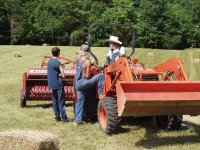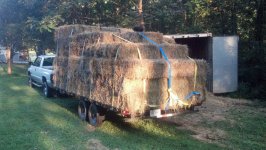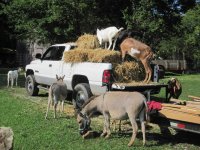I normally use square bales, about 50 lbs each, since I can (normally) handle them easily. A round bale needs power equipment for handling. However, the hay is usually cheaper in round bale form. I recently bought a hay spear that fits both my tractor and my skid steer, basically a long pointed spear to stab and lift a heavy round bale. I don't have good storage yet for round bales but hope to put up another building soon. You can stack round bales 3-4 levels high in the dry and they will keep all year. If you can't keep it dry while feeding, it can degrade quickly and be unsuitable for horses, although it will usually still be OK for cattle.
I have a "hay hut" made to hold one round bale off the ground and kept dry with a roof overhead. This is our first experiment with a round bale in the hay hut. Three horses consumed the $50 bale in 10 days, a about a $75 savings over feeding equivalent square bales for 10 days. The horses clean up every tiny bit, even reaching under the curved steel supports that hold the round bale off the ground.
To keep the surrounding ground from turning into a horribly muddy mess in the winter I used a time-honored method - I removed 6-8" of soil from a 20x20' square, put down a layer of heavy geotextile fiber mat, then filled the hole with crusher-run gravel. Not a bit of mud since. I also did this around the horse shelter, the automatic livestock waterer, and other areas that get heavy use. 1000lb horses can quickly churn up the ground! Before this treatment, it was common to walk in 6" or more of mud. Beside a friend's barn it got so bad the cows had mud to their bellies and his wife got stuck and had to be pulled out. After the fix, that area is as hard as pavement. (The US Dept of Agriculture requires this method for HUAs, high use areas, when distributing conservation grants)
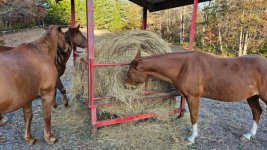
Hay fires are a real problem and entirely due to incompetence, inexperience, impatience, bad luck, or just plain lack of intelligence. Many barns have burned to the ground and many animals (and some people) have died - some animals tend to run into their "safe place" in the barn when they sense danger. I know a guy who lost his horse and most of his goats (and the entire barn) from a fire. Fortunately, he had a lot of friends and co-workers so a couple of us organized an old-fashioned barn raising - built a new barn for him in two days!
Hay fires are easily prevented - never, ever stack damp hay. One wet bale may get hot inside but when packed tight with others it's a fire waiting to happen. Hay that is improperly dried will generate heat inside and can spontaneously combust. When cutting and baling you HAVE to keep an experienced eye on the weather and know how to tedder properly (stir up the loose hay on the ground) so it can dry before baling. This is the same for both round and square bales. If hit with an unexpected rain during the drying, you can just tedder again and again as long as the weather eventually cooperates. If it rains on dry bales of hay either while in the field or stacked on a trailer, they may or may not be ruined, depending.
Note that even the best hay will contain some moisture - too much moisture is the problem. Even if there is not enough moisture to generate heat, a little too much moisture with no ventilation can lead to mold which can be toxic to livestock.
Hay that is stored improperly can also be a problem. For example, stack hay on pallets then cover tightly with a tarp. Moisture from the ground can get into the hay and cause the same problems. There is a way to do it right if you know how. Best way to store is in a large open shed, well protected from direct and blowing rain. Lots of ventilation.
I use an 8x8x40' aluminum shipping container to store most of the hay I need for the winter. Closing up any container tightly can be a problem so I modified it - I designed rain-shielded vents for around the bottom and installed rotating vents on the roof. I also stack the hay with some air space between the stacks and next to the walls. No problems in nearly 20 years now.
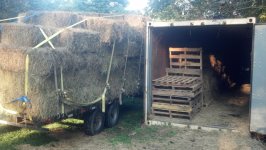
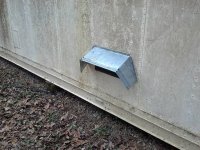
I once bought 40 square bales from a guy and he was proud of how heavy they were, a great value he said. I put them in my storage then on a whim put thermocouple probes down into the middle of a couple of bales. I watched the temperature rise inside until at 160-degF I pulled them all out and threw them into my compost. The seller wouldn't believe they were bad and refused to refund the money. Oh well, he will suffer in the long run by being such a person!
Compost piles also can get very hot inside due to the moisture. I keep three large compost piles in various stages of composting, mixing fresh manure and plant matter with soil for the first pile, then move the piles toward the end of the line over a year until the last one is ready to spread on the garden - rich, wonderful, natural fertilizer. When I turning the piles over occasionally (they need air as well as moisture to compost properly), I often see ashes and smoke from the heat inside!
More, I'm sure than any normal person want's to know about wet hay! I'm certainly no expert, just have a bit of experience.
Maybe I'll write a song about this...
Since our farm makes no profit a good question is why bother with all this. Some reasons:
Annual farm day for one of my kindergarten SS classes.
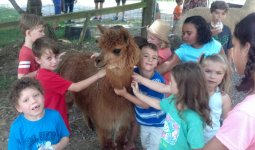
What do you do with a blind horse? You pet it a lot.
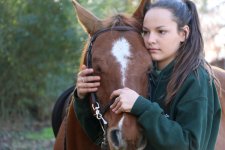
Yes, the old guy rides. Miles of trails here.
Share the blessing.
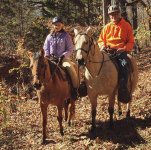
This was the first time this blind, severely autistic
and communication challenged little girl ever
touched or smelled a horse. She was in love!
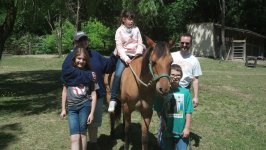
How many kids never get to ride a mini donkey?
If you fall off you're only 2' from the ground.
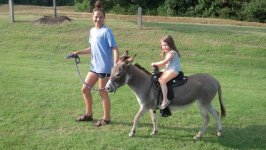

"Teach... your children well..."
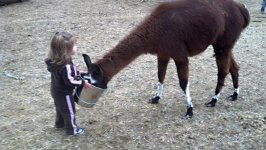
Group from a local assisted living home.
It's good to get outside on a nice day!

Sorry, I got carried away, didn't intend to write a blog. But I have all these thousands of photos...
JKJ



